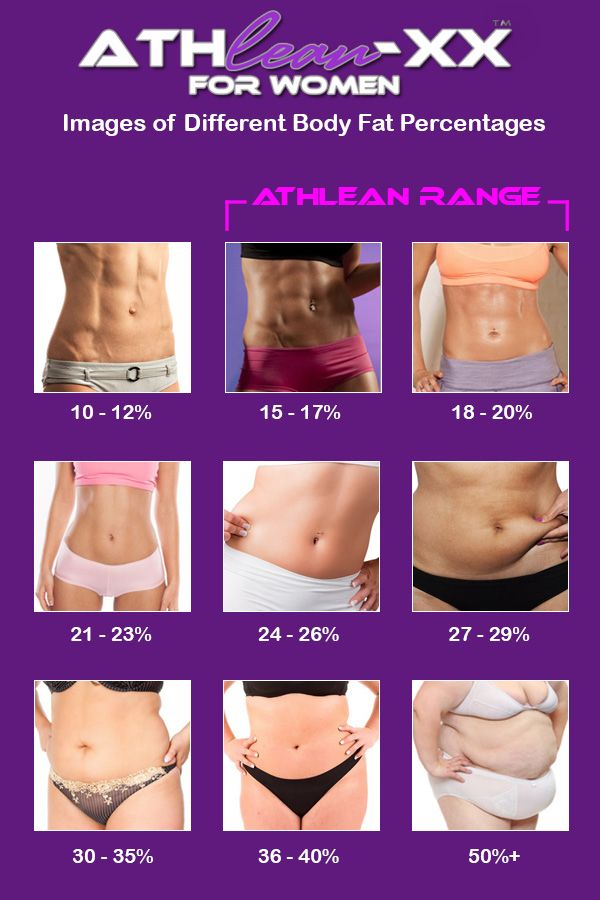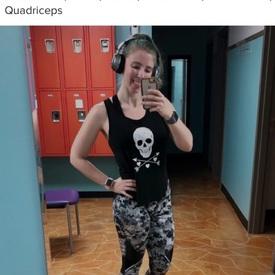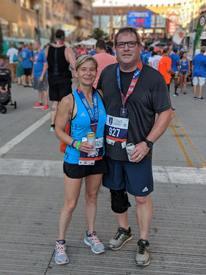Body fat percentage of 37%, but my weight is 138 at 5'5". Seriously???
Replies
-
shadow2soul wrote: »I can't recall ever seeing anywhere where someone has said "eat only ice cream every day as long as you stay under your calorie goal! It's great and you can still lose weight!!"
I've been on these boards for almost 4 years and I don't remember anyone ever advocating that sort of diet. Ever.
Well let me introduce you to IIFYM.
?
OK let me google that for you http://blog.imprettyfit.com/nutrition/iifym-explained/
I know what IIFYM is. I don't get how it pertains to the post you quoted. It certainly isn't a diet of ONLY ice cream.
Sure you can eat ice cream everyday. However that's not what emdeesea said.
0 -
I can't recall ever seeing anywhere where someone has said "eat only ice cream every day as long as you stay under your calorie goal! It's great and you can still lose weight!!"
I've been on these boards for almost 4 years and I don't remember anyone ever advocating that sort of diet. Ever.
Well let me introduce you to IIFYM.
*sigh*
NO. What I meant was that there seems to be this idea with a lot of people on MFP that you CAN'T eat ice cream or Twinkies or donuts or pizza and that everything that goes in your mouth must be "clean." And further, anyone who advocates moderation must mean "OH YOU'RE SUGGESTING EATING NOTHING BUT TWINKIES EVERY DAY."
And what I was saying was that I have never seen anyone advocate eating only twinkies every day to lose weight.
0 -
My Fitbit aria says mine is 40%. I know that is way off because I'm 5'3 and weigh 172. I actually find that funny that it says that when I know my body fat is around 27 to 29%.
How do you know your BF is 27-29%. You would have to be an abnormally muscular woman to have that low of a BF% at that ht and wt. You are obese by BMI standards. I'm not sure it's possible for a woman to have such a low BF% and 30.5 BMI.
Or are you male? I was just going by your avatar and username.0 -
OP, while I agree that scales are very inaccurate, two things jump out at me about your post that may account for your body fat % being higher than you think. Your age and your boob size. Unfortunately, women lose a lot of lean body mass as we age. As we get older, we become mushier. Just the way it is. Walking may help to cut that back a little, but adding at least some light resistance training is likely to have a bigger impact. And if your boobs are a DD? That's a pretty significant amount of fat there. Consider yourself lucky that you can lose weight and still maintain your boobs. For me, they are the first thing to go!0
-
lporter229 wrote: »OP, while I agree that scales are very inaccurate, two things jump out at me about your post that may account for your body fat % being higher than you think. Your age and your boob size. Unfortunately, women lose a lot of lean body mass as we age. As we get older, we become mushier. Just the way it is. Walking may help to cut that back a little, but adding at least some light resistance training is likely to have a bigger impact. And if your boobs are a DD? That's a pretty significant amount of fat there. Consider yourself lucky that you can lose weight and still maintain your boobs. For me, they are the first thing to go!
Guess I'll have to try the resistance training. I do walk a lot (love it!!), so maybe I should carry around some dumbbells...? (Real ones...the weights, not my ex-husband, even though he's the biggest dumbbell around...and pretty weighty too, now that I think about it...but I digress). And yes, the girls have remained at DD throughout my weight loss. Band size went from 40 to 36, but cup size remained constant. I feel a bit better now, thank you! Fat boobs doesn't sound as bad as fat butter belly (although I'll look into resistance training to help get rid of the jiggly bits that remain)0 -
This picture always puzzles me. I really can't tell the difference between 20%-25%-30%-40% reliably and if you asked me to randomly order the women by body fat I certainly wouldn't have come up with this sequence. And then 40%-45% is an absolutely phenomenal jump in phenotype, but she's indistinguishable from 50%.
I also still wouldn't peg the women used as examples of 35% or 40% as having so much fat as to be unhealthy at all, yet the government standard is 30%. So .. there you have it. I find it, or the guidelines, or everything, quite odd.
0 -
@tomteboda - This is another one I came across. I think though they are just meant to be very rough visual guides.

0 -
@shadow2soul My guess is that the leaner the example is the more likely the body fat "range" is accurate as well.0
-
I like these images better and looks more like me. My BF is currently hovering around 28 and this image is more like what I look like at the moment. The previous image (Buildlean) looks nothing like what I did at 30% at all. If I looked like that at 30% I would never have gone on a diet lol!
0 -
Those images mean nothing because they focus on belly fat. So for women who don't carry fat in their belly or have loose skin, it's still a total guess, lol.0
-
gataman3000 wrote: »shadow2soul wrote: »gataman3000 wrote: »
Maybe I am because that's what I am getting, It seems people (not you) are advocating eat whatever you want and you will become just as healthy as the person that has been primarily eating clean nutritious foods.Need2Exerc1se wrote: »gataman3000 wrote: »Need2Exerc1se wrote: »gataman3000 wrote: »gataman3000 wrote: »gataman3000 wrote: »I would incorporate good quality foods, body fat is where the calories in calories out thing is debunked.
Hey its true, stay under your calories and eat twinkies all day and see if your waist size goes down.
Hate to shatter your beliefs, but that experiment has already been done. He lost 27 pounds in 2 months:
http://www.cnn.com/2010/HEALTH/11/08/twinkie.diet.professor/
Lol you find the one study in the corner of the world that fits your argument, so do you really think that if 500 people ate Twinkie diets, the majority of those people will lose a substantial amount of body fat sir?
Whether the fat loss was substantial would depend on how long they ate this way. Do you believe that people can eat only 500 calories per day and not lose fat?
Its just that boards like this where people have a PhD in Google give others that need information bad information, and champion eating bad foods when in reality people need good nutritious food. Most people that want to lose weight, if they lose weight on a Twinkie diet will have severe body composition issues and will need to essentially start their diet again to lose the body fat. If you sit with a nutritionist or people at the gym who are healthy and have a good proportioned body will never tell you " yes go on a Twinkie diet and you will lose fat " because it's not the truth. I just don't want to see people go down a path of failure because some random person did this I'll advised one sided study on twinkies and now people think you can have more twinkies than vegetables.
I think you are misunderstanding the message. It's not "you should only eat Twinkies" It's "you don't have to 100% "healthy foods" to lose weight"
No one is advocating eating a poor diet. Bad information is giving people the notion that they can't ever eat a Twinkie while losing weight.
Most of what I see is that all that matters for weight loss is a calorie deficit. What you eat, however, impacts your health. So yes you can still have pizza, a twinkie, chocolate, or a burger from time to time and still lose weight. If you want to be healthy though, you should make sure to eat plenty of nutritious foods as well. That and it's easier to stick to a deficit if your day is filled with mostly high nutrient low cal foods with only a small treat than it would be to try and eat mostly high calorie/ low nutrient foods.
I 100 percent agree you can eat whatever you want to lose weight, but body composition is where quality foods come in. You can stay in a calorie deficit and lose weight but you will have the same amount of body fat that you started with. People lose weight because they want to look and feel good along with being healthy. Will the number on the scale go down yes will you look and feel good, probably not.
Instead of arguing further, I'll just let Lyle McDonald sort you out.
http://www.bodyrecomposition.com/research-review/hormonal-responses-fast-food-meal.html/
I imagine you posted this to illustrate the main point of the article, Hormonal Responses to a Fast-Food Meal – Research Review. However, what I find striking is:Now it’s worth noting that a great deal of the difference seen between ‘eating clean’ and ‘eating unclean’ has to do with caloric intakes. I’ve pointed out repeatedly that, and this is especially true when people are not counting their calories, certain eating patterns tend to make people eat more than others. It’s easier to overeat donuts than broccoli.
Half of either of the organic test meals, which ranged in calories from 1154 to 1260, would have satisfied me. (In fact, when I make burgers at home, I don't have potatoes or soda, and the meal comes to 525 calories.) I can, however, eat 1260 calories worth of pizza or ice cream. My satiety cues don't kick in for these foods. They are, of course, a different composition, on which McDonald touches.0 -
I'm going to point out the obvious here... You're awesome. And 138 w DDs at 5'5"??! Well, as my doc pointed out to me when I was trying to lose after-baby weight "there's 5lbs and there's 5lbs" - so, using my doc's crude common sense, you're more like 128lbs... Your scale doesn't take your DD-genetics into account!0
-
Weird, it only posted part of my response.
 I also stated buy some v-necks and some flouncy skirts, because at 56 or any age we should all be so lucky!!!
I also stated buy some v-necks and some flouncy skirts, because at 56 or any age we should all be so lucky!!!  0
0 -
gataman3000 wrote: »The scale may not be accurate to the T, but its not 10 to 15 percent off by any means.
I don't think you have any idea what you are talking about.
Every morning when I get on my scale it says my bodyfat is 5%. I think that is because that is the lowest number it can show. If I get back on after dinner it says 27%. I had a BodPod analysis done (it uses air displacement, so similar to the water dunking method and supposed to be pretty accurate) and it said 11%. Based on various calculators using measurements, as well as comparing how I look to pictures, the 11% is correct. Even if it isn't correct the variation between 5% and 27% at different times of day says that my scale is definitely off by at least 10 points (since no matter what the true answer is that answer is more than 10 percentage points different from either 5% or 27%).
Those scales are highly dependent on hydration levels, how clean/dirty your feet are, how thick the skin is on the bottoms of your feet, how long your legs are, where you store fat (legs versus upper body), etc. I think they are pretty much worthless. I only have that feature on my scale because most of them come with it automatically.0 -
The information below comes from: http://halls.md/race-body-fat-percentage/
Deurenberg formula #1: Adult Body Fat % = (1.20 x BMI) + (0.23 x Age) – (10.8 x gender) – 5.4
Deurenberg formula #2: Adult Body Fat % = (1.29 x BMI) + (0.20 x Age) – (11.4 x gender) – 8.0
Gallagher formula: Adult Body Fat % = (1.46 x BMI) + (0.14 x Age) – (11.6 x gender) – 10
Jackson-Pollock formula: Adult Body Fat % = (1.61 x BMI) + (0.13 x Age) – (12.1 x gender) – 13.9
Heritage study: Adult Body Fat % = (1.39 x BMI) + (0.16 x Age) – (10.34 x gender) –9
gender = 1 male, 0 female.
For me the Heritage study formula had the least error.
How does one justify using age or gender to calculate body fat exactly? Every single one of these equations uses only weight, age and gender to determine body fat percentage. You might as well say BMI = BF%. Every single one of these is useless.
I agree. There are formulas out there that use measurements also. I would think those would be much better.0 -
mburgess458 wrote: »The information below comes from: http://halls.md/race-body-fat-percentage/
Deurenberg formula #1: Adult Body Fat % = (1.20 x BMI) + (0.23 x Age) – (10.8 x gender) – 5.4
Deurenberg formula #2: Adult Body Fat % = (1.29 x BMI) + (0.20 x Age) – (11.4 x gender) – 8.0
Gallagher formula: Adult Body Fat % = (1.46 x BMI) + (0.14 x Age) – (11.6 x gender) – 10
Jackson-Pollock formula: Adult Body Fat % = (1.61 x BMI) + (0.13 x Age) – (12.1 x gender) – 13.9
Heritage study: Adult Body Fat % = (1.39 x BMI) + (0.16 x Age) – (10.34 x gender) –9
gender = 1 male, 0 female.
For me the Heritage study formula had the least error.
How does one justify using age or gender to calculate body fat exactly? Every single one of these equations uses only weight, age and gender to determine body fat percentage. You might as well say BMI = BF%. Every single one of these is useless.
I agree. There are formulas out there that use measurements also. I would think those would be much better.
Maybe none of them are perfect, but I don't think these are particularly bad either. M/F because women tend to carry more fat than men; age because we tend to have less muscle mass when we are older.
So far as using one with measurements Navy tape gives me one number, then another measurement style calculator that is supposed to be better for women and includes wrist/forearm/waist/hip gives me a lower percentage, 6% less IIRC.0
This discussion has been closed.
Categories
- All Categories
- 1.4M Health, Wellness and Goals
- 396.1K Introduce Yourself
- 44.1K Getting Started
- 260.8K Health and Weight Loss
- 176.3K Food and Nutrition
- 47.6K Recipes
- 232.8K Fitness and Exercise
- 448 Sleep, Mindfulness and Overall Wellness
- 6.5K Goal: Maintaining Weight
- 8.6K Goal: Gaining Weight and Body Building
- 153.3K Motivation and Support
- 8.2K Challenges
- 1.3K Debate Club
- 96.4K Chit-Chat
- 2.5K Fun and Games
- 4.4K MyFitnessPal Information
- 16 News and Announcements
- 18 MyFitnessPal Academy
- 1.4K Feature Suggestions and Ideas
- 3K MyFitnessPal Tech Support Questions









